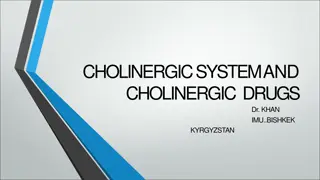Neurologic Disorder
Structural divisions of the central and peripheral nervous systems, learn about neuron anatomy, the neuromuscular junction, and the role of neurotransmitters. Includes information on Acetylcholine, Norepinephrine, Dopamine, and Serotonin.
0 views • 24 slides
Indirect-Acting Cholinergic Drug
Explore the classification, mechanism of action, and pharmacological effects of indirect-acting cholinergic drugs such as anticholinesterases. Learn about the importance, main uses, adverse effects, and contraindications of these drugs. Discover how anticholinesterases increase acetylcholine concent
1 views • 16 slides
Understanding Screening Models for Anti-Alzheimer Drugs
Alzheimer's disease is a prevalent neurodegenerative brain disorder characterized by memory loss and other cognitive impairments. This article discusses the etiology, risk factors, and pathophysiology of Alzheimer's disease, along with in-vitro screening models used to test potential drugs, focusing
0 views • 24 slides
Cell Communication and Signalling in Biology
Cells communicate through extracellular signalling molecules that bind to specific receptors on target cells, leading to changes in cellular behavior. Hormones such as steroid and peptide hormones, neurotransmitters like nor-adrenaline and acetylcholine, play crucial roles in cell signaling. Recepto
0 views • 25 slides
Understanding Indirect Acting Cholinergic Drugs: Mechanism, Classification, and Clinical Applications
Explore the world of indirect acting cholinergic drugs, also known as anticholinesterases, which work by inhibiting acetylcholinesterase to increase acetylcholine levels at cholinergic receptors. Learn about their mechanisms of action, classification, kinetics, dynamics, uses, adverse effects, contr
1 views • 10 slides
Understanding Motor Units and Neurotransmitters in Muscle Contraction
Motor units consist of a motor neuron and the muscle fibers it innervates. Neurotransmitters like acetylcholine play a vital role in stimulating muscle contraction by transmitting signals at the neuromuscular junction. This communication between neurons and muscles is essential for proper movement a
0 views • 30 slides
Understanding the Biological Basis of Human Motion and Motor Learning
In the biological basis of human motion, a series of electro-chemical-physical reactions occur at the neuromuscular junction, enabling nerve stimulation for muscle contraction. Nerve impulses for movement originate in the central nervous system or muscles, with acetylcholine transmitting impulses be
0 views • 13 slides
Understanding Cholinergic Neurons and Agonists in Pharmacology
Cholinergic neurons play a vital role in neurotransmission by utilizing acetylcholine (ACh) as a neurotransmitter. This neurotransmission involves steps like synthesis, storage in vesicles, release, receptor binding, degradation, and recycling of choline and acetate. Choline acetyltransferase cataly
0 views • 30 slides
Overview of the Central Nervous System and Neurotransmitters
The human central nervous system (CNS) is composed of neurons that transmit information through electrical impulses and neurotransmitters at synaptic junctions. Synapses play a crucial role in interneuronal communication, with various types and features impacting information transmission. Neurotrans
0 views • 13 slides
Understanding Myasthenia Gravis: Symptoms, Diagnosis, and Management
Myasthenia Gravis (MG) is a neuromuscular disorder characterized by muscle weakness and fatigability due to a decrease in acetylcholine receptors at neuromuscular junctions. It primarily affects individuals in two age peaks, with different symptoms and gender predominance. The cardinal feature is we
0 views • 25 slides
Understanding Neuromuscular Junction Disorders with Dr. Hana Albulaihe
An in-depth exploration of neuromuscular junction (NMJ) anatomy, physiology, and associated disorders by Dr. Hana Albulaihe, a renowned Consultant Neurologist. The NMJ comprises the axon terminal of a motor neuron and the motor end plate of a muscle fiber. Disorders discussed include Myasthenia grav
0 views • 75 slides
Understanding the Parasympathetic Nervous System and Cholinergic Pharmacology
Dive into the world of the parasympathetic nervous system and cholinergic pharmacology, exploring concepts like cholinomimetics, parasympathomimetics, cholinolytics, and more. Discover how acetylcholine synthesis and degradation play crucial roles in these processes, and learn about different cholin
1 views • 27 slides
Understanding Cholinergic Transmission in Neurohumoral Signaling
Cholinergic transmission plays a crucial role in neurohumoral signaling, involving the release of acetylcholine at synapses and neuroeffector junctions. Dr. Rashmi Rekha Kumari explains the synthesis, storage, release, and catabolism of acetylcholine, highlighting the role of choline acetyl transfer
0 views • 11 slides
Understanding the Cholinergic System and Cholinergic Drugs
The cholinergic system plays a crucial role in the transmission of signals within the nervous system. Acetylcholine (ACh) is the primary neurotransmitter involved in cholinergic transmission, impacting various physiological functions. Cholinergic neurons synthesize ACh through a complex process invo
0 views • 43 slides
Understanding Skeletal Muscle Relaxants and Muscle Contraction Mechanisms
Skeletal muscle relaxants play a crucial role in relaxing muscles without affecting consciousness significantly. They are classified into neuromuscular blockers and spasmolytics, each targeting different mechanisms in the body. Muscle contraction occurs through the release of acetylcholine and the s
0 views • 27 slides
Insights into Nicotine Effects and Smoking Cessation Medications
Nicotine acts as an agonist at nicotinic acetylcholine receptors in the brain, impacting dopamine release and opioid activity. It has a short half-life and is metabolized by the liver. Understanding its sedative effects at high doses and the development of tolerance and withdrawal symptoms is crucia
0 views • 29 slides















